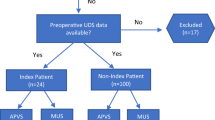Abstract
Introduction and hypothesis
We noninvasively compared urinary flow in both pre- and post-transobturator tape (TOT) procedures in stress urinary incontinence (SUI) patients using previously reported corrected flow–age nomograms in healthy women.
Methods
This retrospective cohort study included patients who underwent a successful TOT procedure to treat SUI. Non-instrumented uroflowmetry was performed before and 3 months after surgery. Corrected maximum flow rate (cQmax) and average flow rate (cQave) were calculated using Qmax/√voided volume (VV) and Qave/√VV respectively. The ratio of corrected flow to age-adjusted corrected flow in healthy women was calculated in each patient. Each parameter was compared against pre-TOT and 3-months post-TOT values.
Results
Sixty-two patients were eligible for study inclusion. All urinary flow parameters were significantly higher pre-TOT than at 3 months post-TOT. The number of patients with cQmax and cQave over mean flow–age nomogram, compared with healthy women, before the TOT procedure decreased 3 months post-TOT; however, in many patients, cQmax and cQave were higher than in the corrected flow–age nomogram post-TOT. No significant difference in the ratio of cQmax to age-adjusted cQmax between pre- and post-TOT in the normal urinary flow group was observed, but significantly decreased in the high urinary flow group 3 months after TOT.
Conclusions
Urinary flow rates were higher in SUI patients compared with age-matched controls and successful TOT procedures normalized urinary flows in patients with high urinary flow. A simple evaluation of urinary flow using a corrected flow–age nomogram may be clinically useful in SUI patients.


Similar content being viewed by others
Abbreviations
- ALPP:
-
Abdominal leak point pressure
- BMI:
-
Body mass index
- cQave:
-
Corrected average flow rate
- cQmax:
-
Corrected maximum flow rate
- MUS:
-
Mid-urethral sling
- POP:
-
Pelvic organ prolapse
- PVR:
-
Post-void residual volume
- Qave:
-
Average flow rate
- Qmax:
-
Maximum flow rate
- SUI:
-
Stress urinary incontinence
- TOT:
-
Transobturator tape
- TVT:
-
Tension-free vaginal tape
- VV:
-
Voided volume
References
Verghese T, Latthe P (2014) Recent status of the treatment of stress urinary incontinence. Int J Urol 21:25–31
Stav K, Dwyer PL, Rosamilia A, Schierlitz L, Lim YN, Lee J (2010) Risk factors of treatment failure of midurethral sling procedures for woman with urinary stress incontinence. Int Urogynecol J 21:149–155
Nilson CG, Palva K, Aarnio R, Morcos E, Falconer C (2013) Seventeen years’ follow-up of the tension-free vaginal tape procedure for female stress urinary incontinence. Int Urogynecol J 24:1265–1269
Petros PE, Ulmsten UI (1990) An integral theory of female urinary incontinence. Experimental and clinical considerations. Acta Obstet Gynecol Scand Suppl 153:7–31
Delancey JO (1994) Structural support of the urethra as it relates to stress urinary incontinence: the hammock hypothesis. Am J Obstet Gynecol 170:1713–1720
Kraus SR, Lemack GE, Sirls LT, Chai TC, Brubaker L, Albo M, Leng WW, Lloyd LK, Norton P, Litman HJ, Network UIT (2011) Urodynamic change associated with successful stress urinary incontinence surgery: is a little tension a good thing? Urology 78(6):1257–1262
Kuo HC (2001) The surgical results of the pubovaginal sling procedure using polypropylene mesh for stress urinary incontinence. BJU Int 88:884–888
Dietz HP, Ellis G, Wilson PD, Herbison P (2004) Voiding function after tension-free vaginal tape: a longitudinal study. Aust N Z J Obstet Gynaecol 44:152–155
Sander P, Møller LM, Rudnicki PM, Lose G (2002) Does the tension-free vaginal tape procedure affect the voiding phase? Pressure-flow studies before and 1 year after surgery. BJU Int 89:694–698
Zullo MA, Plotti F, Calcagno M, Marullo E, Palaia I, Bellati F, Basile S, Muzii L, Angioli R, Panici PB (2007) One-year follow-up of tension-free vaginal tape (TVT) and trans-obturator suburethral tape from inside to outside (TVT-O) for surgical treatment of female stress urinary incontinence: a prospective randomised trial. Eur Urol 51:1376–1382
Barapatre Y, Agarwal MM, Singh SK, Sharma SK, Mavuduru R, Mete UK, Kumar S, Mandal AK (2009) Uroflowmetry in healthy women: development and validation of flow-volume and corrected flow-age nomograms. Neurourol Urodyn 28:1003–1009
Siroky MB, Olsen CA, Krane RJ (1979) The flow rate nomogram: I. development. J Urol 122:665–668
Heylen BT, Ashby D, Sutherst JR, Frazer MI, West CR (1989) Maximum and average urine flow rates in normal male and female populations–The Liverpool nomograms. Br J Urol 64:30–38
Haylen BT, Parys BT, Anyaegbunam WI, Ashby D, West CR (1990) Urine flow rates in male and female urodynamic patients compared with the Liverpool nomograms. Br J Urol 65:483–487
Mueller ER, Litman H, Rickey LR, Sirls L, Norton P, Wilson T, Moalli P, Albo M, Zimmern P (2015) Comparison of flowrates and voided volumes during non-instrumented uroflowmetry and pressure-flow studies in women with stress incontinence. Neurourol Urodyn 34:549–553
Abrams P, Cardozo L, Fall M, Griffiths D, Rosier P, Ulmsten U, van Kerrebroeck P, Victor A, Wein A (2002) The standardisation of terminology in lower urinary tract function: report from the standardisation sub-committee of the International Continence Society. Am J Obstet Gynecol 187:116–126
Salin A, Conquy S, Elie C, Touboul C, Parra J, Zerbib M, Debré B, Amsellem-Ouazana D (2007) Identification of risk factors for voiding dysfunction following TVT placement. Eur Urol 51:782–787
Mostafa A, Madhuvrata P, Abdel-Fattah M (2011) Preoperative urodynamic predictors of short-term voiding dysfunction following a transobturator tension-free vaginal tape procedure. Int J Gynaecol Obstet 115:49–52
Cho ST, Song HC, Song HJ, Lee YG, Kim KK (2011) Predictors of postoperative voiding dysfunction following transobturator sling procedures in patients with stress urinary incontinence. Int Neurourol J 14:26–33
Kim S, Bae J, Cho M, Lee K, Lee H, Jun T (2014) Effect of preoperative flow rate on postoperative retention and voiding difficulty after transobturator tape operation. Korean J Urol 55:190–195
Author information
Authors and Affiliations
Corresponding author
Ethics declarations
Conflicts of interest
None.
Rights and permissions
About this article
Cite this article
Kitagawa, Y., Narimoto, K., Urata, S. et al. High urinary flow in women with stress incontinence: corrected flow–age nomogram evaluation after a transobturator tape procedure. Int Urogynecol J 27, 1075–1080 (2016). https://doi.org/10.1007/s00192-016-2943-6
Received:
Accepted:
Published:
Issue Date:
DOI: https://doi.org/10.1007/s00192-016-2943-6




